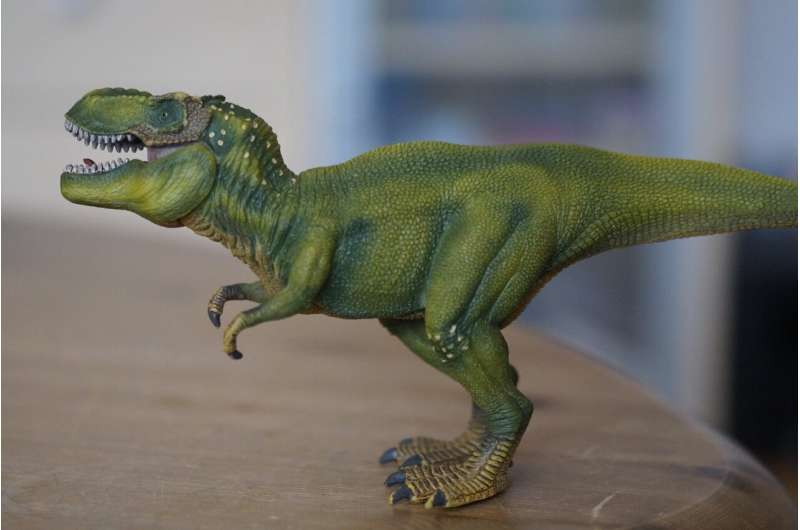This article has been reviewed according to Science X's editorial process and policies. Editors have highlighted the following attributes while ensuring the content's credibility:
fact-checked
trusted source
written by researcher(s)
proofread
Five things you probably have wrong about the T rex

An icon from the age of dinosaurs, Tyrannosaurus rex has featured in everything from blockbuster movies to the shape of chicken nuggets. As a creature to be feared for its bone-crushing bite or ridiculed for its inability to give a high five, T rex has captured the imagination of children and adults alike.
One skeleton broke records in 2020 when it sold at auction for US$32 million (£25 million). But how well do you really know T rex? Here is the truth behind five common misconceptions about this dinosaur.
Myth: T rex had bad eyesight
Scientists think that T rex had excellent vision, despite what Jurassic Park might have you believe. The grapefruit-sized eyes of T rex could have distinguished objects with up to five times more precision than those of a falcon and 13 times better than a human.
They also had superior color vision. Like birds and crocodiles, T rex could distinguish more colors of the rainbow than humans and see ultraviolet light. Although it makes for good dramatic tension in fiction, standing still would not hide you from a hungry T rex.
Myth: Chickens are the direct descendants of T rex
This myth has its origins in truth. All birds, including chickens, are not only descendants of dinosaurs but are themselves dinosaurs. Birds belong to a lineage of dinosaurs closely related to the raptors (including Velociraptor).
Early birds, such as Archaeopteryx, had wings like modern birds but teeth and long tails like their ancestors. These ancient birds first appeared in the Jurassic period, millions of years before T rex evolved.
Scientists have identified an ancestor of modern ducks and chickens as the quail-sized Asteriornis, nicknamed the wonderchicken by scientists. It was still living at the time of T rex. A handful of these humble bird species survived the mass extinction that killed their dinosaur relatives and evolved into all the birds we know today.
T rex, rather than being the grandparent of the modern chicken, is more like an oversized cousin to all birds.
Myth: T rex had tiny, useless arms
Muscle reconstructions show that T rex arms were strong for their size and had a reasonable range of motion. It is likely they were used in a range of behavior.
The most plausible suggestions scientists have come up with so far include slashing and holding onto prey and use in communicating between T rex individuals.
T rex actually couldn't twist its arms to make its hands face palm downward, as is commonly depicted. To improve the accuracy of your next T rex impression, face your palms towards each other, as if clapping.
At around one meter long, T rex arms are larger than human arms but still small compared with their 13-meter long bodies. Small arms are common among larger theropods (two-legged, predatory dinosaurs) and have evolved several times in this group. Other dinosaurs in this group had even smaller arms.
The eight-meter long Carnotaurus, a horned predator from South America, had stubby arms less than 50 centimeters long.
Myth: T rex lived alongside Stegosaurus
The age of dinosaurs was probably longer than you think. T rex lived at the end of the Cretaceous period, just before the dinosaur-killing asteroid strike 66 million years ago. Stegosaurus, and other popular Jurassic dinosaurs such as Diplodocus, lived around 150 million years ago.
T rex lived closer to the modern day than to the time of Stegosaurus. By the time T rex walked the Earth, Stegosaurus were already fossils beneath their feet.
Myth: T rex was scaly and gray or green
The idea that T rex might have had feathers is contentious, even among paleontologists. There is evidence of feathers in many dinosaur species, leading some scientists to conclude that feathers were widespread among dinosaurs. Yutyrannus, a nine-meter long relative of T rex, was found preserved with a coat of fuzzy feathers.
So does this mean T rex was also fluffy? Not so fast. Some scientists think that a full feather coat would leave the giant, warm-blooded T rex at risk of overheating.
This thinking is supported by preserved patches of skin found from many parts of the body that appear to be scaled. Although we don't know for certain either way, the real T rex was probably something between fully scaly and fully fuzzy.
The science of dinosaur color is one of the most exciting developments in recent paleontology. Scientists have been able to determine the colors and patterns of some exceptionally well preserved dinosaurs by studying fossilized pigment-containing capsules within cells in feathers and scales.
Although no one has worked out what color T rex was yet, we now know that dinosaurs came in a range of colors, including red and iridescent black, and patterns such as stripes.
Provided by The Conversation
This article is republished from The Conversation under a Creative Commons license. Read the original article.![]()





















